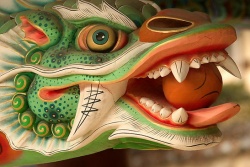Kuzuryū
Jump to navigation
Jump to search
- Kuzuryū (九頭龍 nine-headed dragon?), or Kuzuryūshin (九頭龍神 nine-headed dragon god?) is a deity that appears in folklore and legends of various parts of Japan, including, for example, Hakone (Kanagawa), Nagano Prefecture and Fukui Prefecture. In many cases, the Kuzuryū is associated with water.
- Hakone Kuzuryū legend
- During the Nara period, a legend arose that the Nine-headed Dragon had settled in Lake Ashi in Hakone, and that it demanded a sacrifice. To appease the dragon, the villagers agreed to select a house by shooting a white-feathered arrow and seeing where it landed, then sacrificing the daughter of the house. A priest named Mankan (万巻上人) cursed the dragon, and is said to have chained it to the Upside-down Cedar (an underwater rock formation). As a result of this legend, the dragon came to be worshipped as Kuzuryū Daimyōjin (九頭竜大明神 "Great God Nine-Headed Dragon?). The expression "send up a white-feathered arrow" has come to mean "choose by lot."
- The legend continues, saying Mankan saw the dragon reform and change into a dragon king. He then built a shrine to the dragon. After this the customary offering to the dragon changed from human sacrifice to steamed rice with red beans.
- Other Kuzuryū legends
.
- Kuzuryū in Togakushi, Fukui prefecture
- Kuzuryū is said to have appeared in response to the echoing sound of a rock door to a cave torn off by another god, and flung down to earth. The thrown door became Mount Togakushi, and Kuzuryū became a nearby mountain of the same name. At the foot of Mount Togakushi resides Togakushi Shrine, where a small shrine dedicated to the Kuzuryū can be found.
- Kuzuryū and Buddhism
- The Kuzuryū derives from the Hindu figure Shesha, via Buddhism. Shesha is a Nagaraja that appears in an Indian myth, and it is 1 of 1000 that arose between Kashyapa and Kadru Nāga. The appearance is of a huge snake that has 1000 heads. The earrings, the crown, and the corolla that is attached to each one of 1000 heads of the sign of the swastika are acquired.
- When introduced into China because of the spread of Buddhism, the concept of nagas became dragon kings (竜王) and then in turn developed into Kuzuryū in Japan,
